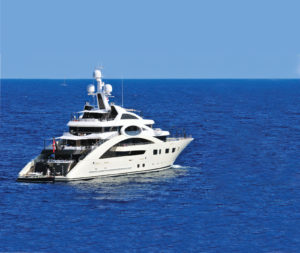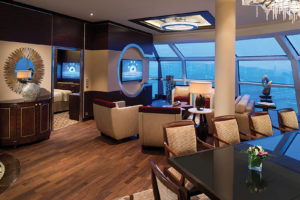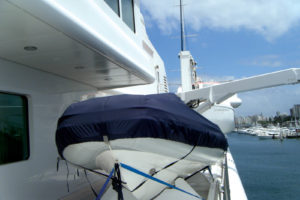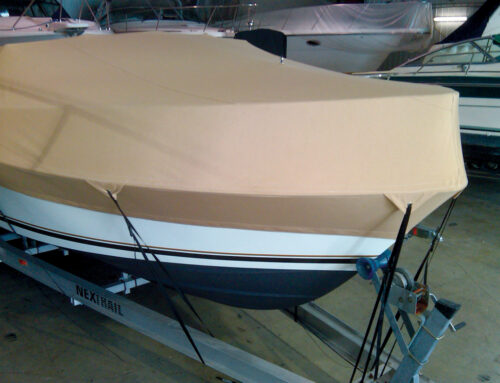Luxury ships offer design challenges and opportunities

There is a discernible difference in the techniques used by fabricators for large vessels as compared to smaller recreational craft, including scale, expense and scheduling. Photo: CHRISTO303
When you think about ocean, lake or river cruise lines, what comes to mind? Luxury travel, certainly. Beautiful, natural surroundings, definitely. And the ships themselves: large, luxurious liners, with dining, entertainment and staff that attend to your every need, allowing you to enjoy your experience to the fullest. Marine fabricators who orchestrate the exterior and interior fabric applications understand the fabric properties and technical aspects that are required within this unique segment of the marine industry.
Challenges aplenty
Hans Galutera understands cruise-ship fabrication. During his long career, Galutera, MDIA, SBID, co-founder and principal at BG Studio International in New York, N.Y., and IDA NY chapter president, has worked on approximately 20-plus ships—mainly for Celebrity Cruises and Royal Caribbean International (RCCL).
BG Studio International started with a small cruise brand named Boleros on a unique lengthening project with RCCL’s Enchantment of the Seas. “Since then, we have worked on numerous restaurants, bars, lounges and penthouse suites, the most recent being an award-winning presidential suite onboard Celebrity Reflection,” Galutera says. He adds there are always a number of challenges designing cruise ships, in general, because marine fabricators have to become experts in designing for extreme conditions.
“Our field is very specialized, and we are the only actual interior-design studio in New York City that focuses on ship design,” Galutera says. “Land-based projects are very different than sea-based with the following restrictive main points: structural, technical, mechanical, environmental sustainable, weight issues and, most important, maximizing real estate on a very restrictive and contained space that moves.”
For every cruise-ship project, there is a building code Galutera and BG Studio International abides by called SOLAS (Safety of Life at Sea). “Similar to the International Building Code, but more stringent, it takes time to train our design team with a minimum of two to three years before they can actually work on a project,” Galutera says.
Krisha Plauché, associate ASID principal designer at Onboard Interiors in Marblehead, Mass., also understands the nuances of cruise-ship fabrication. Onboard Interiors has worked on three cruise vessels—two casino ships out of a location north of Boston, but which hail from Florida, and one dinner-cruise ship that will be calling the Boston harbor “home.”
According to Plauché, when it comes to cruise-ship fabrication, timing is everything.
“Timing was a big challenge of the cruise-ship vessels as we have to coordinate re-upholstering items while vessels are in dry dock for a limited time,” she says. “Or we have to work overnight on items in batches while the vessel is docked in order to return items so the vessel can sail at scheduled times.”
Another unique challenge marine fabricators who work on cruise vessels face is using fabrics that are up to fire-safety codes, since items for cruise ships need to meet both traditional fire-department and Coast Guard fire ratings.
For the casino cruise ships that Onboard Interiors worked on, the chosen fabrics needed to be durable, easy to clean and vibrant. That’s why Plauché and her team had meetings with vessel owners to decide overall design. “We also met with the crew to decide which areas were in most need of repair and why,” she says. “For example, when meeting with one of the restaurant servers onboard, they mentioned that the older customers don’t like to leave their seats once they sit down at a slot machine, which means that even when ‘nature calls,’ they avoid leaving their seat—a truly terrible thought.”
Marine fabricators working on cruise-ship designs also need to take into consideration that some guests get seasick and don’t make it to the restroom, and other cruise travelers often spill drinks and food onto seats and chairs—especially when the seas are rough and choppy.
“So taking all that into account, we used a special, contract-grade, durable vinyl in vibrant jewel tone colors for the casino project,” Plauché says. There were approximately 500 items Onboard Interiors needed to construct, so they cut templates and used a systematic production line for the pieces of which they needed to make 10 or more.
“We had to coordinate pieces to save time with such a limited turnaround,” Plauché says. “Being organized is key, as is keeping everything running smoothly and keeping everyone involved happy. You also need to stay on a tight schedule, manage meetings with contact people, and keep tabs on fabric and the fabric reorder times.”
Plauché got involved with the cruise-ship industry by connecting with a captain of a vessel who was looking to refit items. “That led to another vessel in his fleet needing work and that led to another captain finding out about our services and resources,” Plauché says.
So why does Plauché continue to be interested in working within the challenging cruise industry? “It’s a unique business, one that might require being in the right geographic places to assist these unique vessels,” she says.
Specifying materials

Restaurants, bars, lounges, penthouse-even presidential suites-are typical large-ship fabrication projects, and all must meet Safety of Life at Sea building codes.
Terri Madden, owner of Sand Sea Air Interiors (SSA) in San Juan, Puerto Rico, also has provided services for international vessels travelling through Puerto Rico that are upward of 300 feet in length. One such vessel was Le Grand Bleu, one of the largest private cruise vessels in the world, measuring 341 feet in length.
As Madden explains, Sand Sea and Air Interiors views every cruise ship space with an eye for uncovering its potential—whether new construction or redesign. SSA offers full-scale design consulting, from conception to implementation, or advice on a project already in place. The firm incorporates design principles in all work—from spaces, furniture and window treatments to textiles, hardware and accessories.
“For large luxury vessels, we work directly with a first officer or captain, as the owners are usually not on board,” Madden says. “The scope of work, materials and job costs are approved by the captain, with payments often by wire transfer. We feel it is important to clarify these details prior to commencing work.”
Madden and her team are contacted often for repairs of large vessels traveling through Puerto Rico. “Frequently we need to use the same material as is on the boat,” Madden says. “Usually this is a material familiar to SSA because of the vendor contact we have with IFAI/MFA. As an active member, we attend their trade shows to keep abreast of recent advances for marine materials and hardware. Materials such as Sunbrella and Serge Ferrari Stamoid are widely used.” There are also numerous designers using materials suitable for marine applications, all of which can be easily shipped to Puerto Rico.
For Galutera and his team, the fabrics and materials used within their cruise-ship projects need to be flame-retardant and finished with special durable finishes such as Krypton or Nanotex. But most important, they must be approved with the International Maritime Organization seal of approval.
Strategies for success
When it comes to the kinds of techniques used by fabricators for cruise ships and large vessels (as compared to smaller personal recreational craft) there is a discernible difference.
“There are a lot of differences in terms of scale, expense and, most importantly, schedule,” Galutera says. “Schedule is the primary motivating factor, and everyone loses money if it is not delivered on time—including the designers. The bigger vessels are built like giant Lego blocks and built in zones. Depending on the shipyard, they are typically built from bottom to top. Some have to be built from the aft [back of ship], other yards build them from the center and always in sections.”

The main concern for any cruise-ship project whether personal, recreational or consumer-based cruise ships – is quality.
Of course, the main concern for any cruise-ship project—whether personal recreational or consumer-based cruise ships—is quality. “We may be asked to replace or duplicate an original item, thereby maintaining the same design as the original or a product that matches other items on the vessel,” Madden says. Depending on the age of the cruise ship and where it may have been originally constructed, duplicating fabrics can be challenging.
Often Sand Sea and Air Interiors needs to provide services within a tight time span, and if their schedule can be adjusted, they do so. “If our team has to work extra hours, we let the captain know and bill accordingly for the overtime,” Madden says. “Occasionally, we have to coordinate around work by other contractors or time limits for our accessibility to work within certain areas of a vessel.”
Madden says today’s marine fabricators interested in cruise vessels need to be solution-based designers—using a blend of wisdom and current design, science and sense.
And be aware of the rules and regulations that specifically apply to the cruise-ship industry. “Go to industry events such as Seatrade, but most importantly, contact the people who do work for ships and yachts,” Galutera says.
Finally, note there are worldwide companies acting as operations representatives providing shipping services for large vessels. “Sand Sea and Air Interiors is a local liaison for these representatives and is contacted on an ‘as needed’ basis,” Madden says. “Expanding services to large cruise vessels can be a win/win opportunity. Just think about it, plan it and do it.”
Maura Keller is a freelance writer from Plymouth, Minn.
 TEXTILES.ORG
TEXTILES.ORG 






